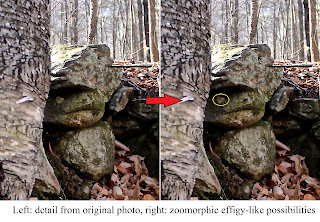This photo caught
my eye, as I was “searching Google for a similar image” of something:
It took me a minute or two, but there it was, as I opened up the photo in its own big window:
So I made my way
to "Thinking Big" DECEMBER 6, 2015 http://wondermyway.com/2015/12/06/thinking-big/
“Wonder along with
me as I wander through the woods,” writes Leigh Macmillen Hayes. “I’m a Maine
Master Naturalist and a freelance writer. My happy moments are spent wandering
and wondering in the woods of western Maine. And photographing and sketching
what I see. And writing about the experience. And trying to find out the
answers. Honestly though, I don’t want to know all of the answers.”
I followed that kind
invitation, up to the White Mountains in Maine, wandered along and saw that some
“Single and double-wide stone walls line the old road and mark pastures and
gardens. Miles of walls.” There’s a lot that is familiar, both in what Hayes
writes and in the photo as well. I spend a lot of time doing the same sort of wandering
and wondering along old Indian Trails that have become roads, some paved, but
also along abandoned roads. I often look for stone walls along them – and look
closely into how they are made, imagining the landscape before 1620 or 1492,
when fires tended a different landscape, when perhaps it was the trails those
old writers were talking about, burned both in the spring and “after the fall
of the leaf” in autumn – what better and easier way to keep a trail clear or
add a little more of a fuel break between some “gardens” and places that became
later pastures outlined by miles and miles of stone walls?
“And dotting the landscape–piles of rocks picked from the
ground:”
And then an interesting “root cellar” and a foundation (and I recognize the big birch, note more of that construction that is less like the "bricks or blocks" of Euro-American constructions than the effigy-like qualities of placement of stones) –
that kind of thing that makes me wonder about what I think I might see in the
way those stones placed and what might be a far older stone structure, thinking
about that Upton Chamber and other places:
There's the second testudinate effigy-like possibility, cropped from the photo above:
Again, it isn't bricks and blocks as a view of the interior is shown:
“Well...a deep subject,” Leigh writes – or is that some sort of quarry for some sort of
stone?
And the link mentioned of an earlier visit shows more
details:
And even includes a photo of this nearby boulder, accompanied by these words: "We explored the hillside and checked out some boulders taller than us. The ragged edges reminded us that this didn’t get rolled about by the glacier, but may have been part of a boulder field left behind. Sometimes our imagination turned from the historical nature to whimsy. I see a snapping turtle head; someone else saw a frog in this stone formation..."
Nice wandering with you, Leigh Macmillen Hayes. I know I’ll
be checking back in here again, wandering and wondering too…









Very interesting!
ReplyDelete